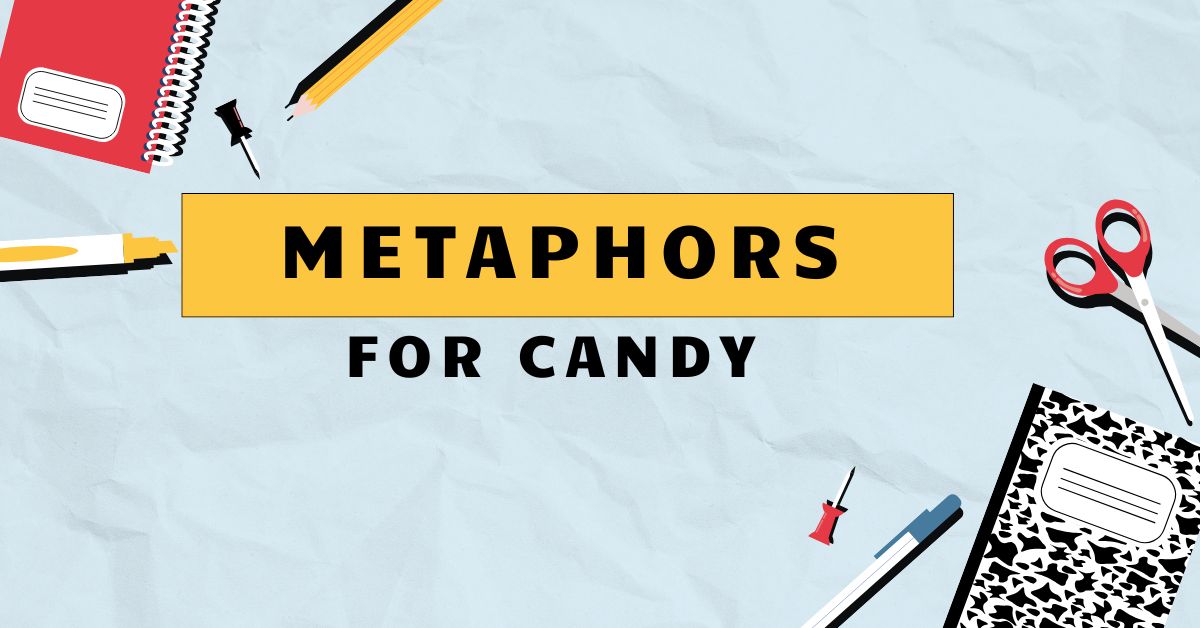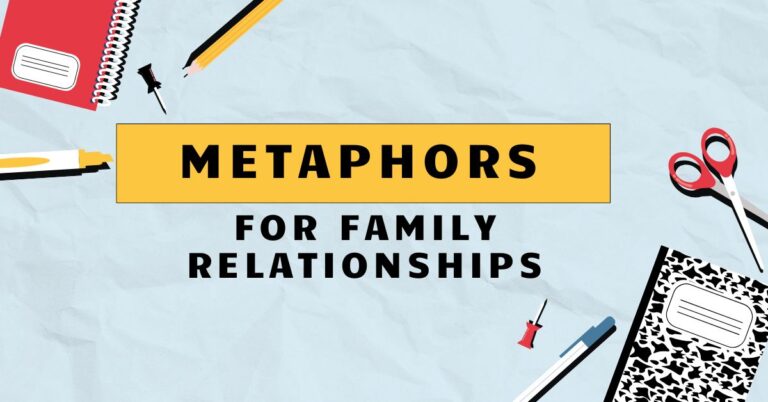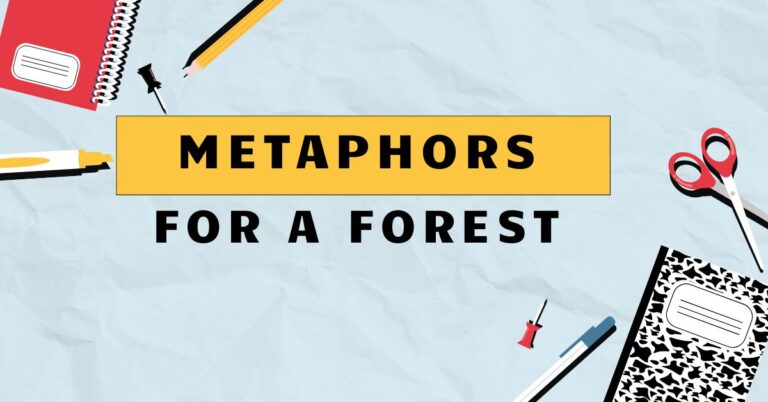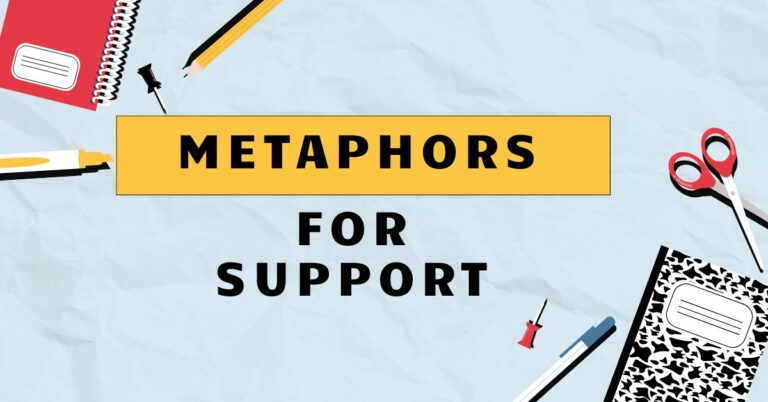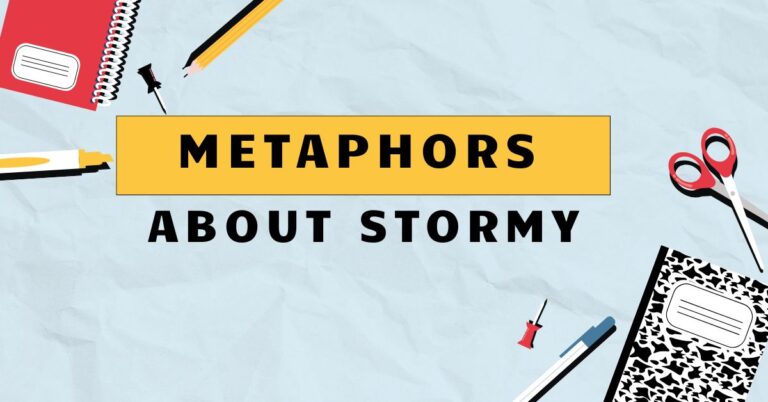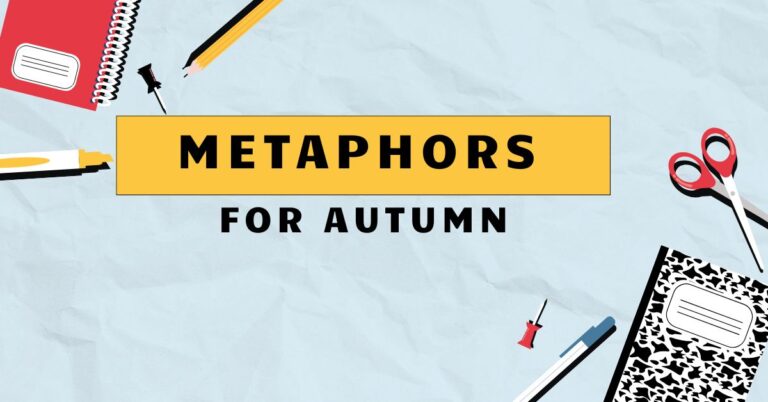41 Metaphors for Candy: Sweeten Your Language Skills
Metaphors are powerful tools in language, allowing us to draw comparisons and create vivid imagery. Understanding metaphors, particularly those related to everyday concepts like candy, enriches our ability to interpret and use figurative language effectively.
This article delves into the world of candy metaphors, exploring their structure, types, and usage. Mastering this area will benefit English language learners, writers seeking to add flair to their work, and anyone interested in the nuances of language.
By the end of this guide, you’ll not only appreciate the sweetness of candy but also the power of metaphorical language.
Table of Contents
- Introduction
- Definition of Metaphor
- Structural Breakdown of Candy Metaphors
- Types and Categories of Candy Metaphors
- Examples of Candy Metaphors
- Usage Rules for Candy Metaphors
- Common Mistakes When Using Candy Metaphors
- Practice Exercises
- Advanced Topics in Metaphorical Language
- Frequently Asked Questions
- Conclusion
Definition of Metaphor
A metaphor is a figure of speech that directly compares two unlike things without using “like” or “as.” It asserts that one thingisanother, creating a vivid and often surprising connection. Metaphors are essential for adding depth, color, and creativity to language.
They allow us to understand abstract concepts by relating them to more concrete or familiar ideas. The effectiveness of a metaphor lies in its ability to resonate with the audience and evoke a specific feeling or understanding.
Classification of Metaphors
Metaphors can be classified in several ways, based on their structure, function, or the relationship between the compared items. One common classification distinguishes betweenexplicit metaphors, where both the subject and the metaphorical term are clearly stated, andimplicit metaphors, where the subject is implied or suggested.
Another way to classify metaphors is based on their conventionality:dead metaphorsare those that have become so commonplace that they are no longer recognized as metaphors (e.g., “the leg of a table”), whilenovel metaphorsare fresh and original, creating a more striking effect.
Function of Metaphors
Metaphors serve several important functions in communication. They cansimplify complex ideasby relating them to something more familiar.
They canevoke emotionsby creating vivid imagery and associations. They canpersuade or influenceby framing an issue in a particular light.
Furthermore, metaphors canadd aesthetic appealto language, making it more engaging and memorable. The specific function of a metaphor depends on the context and the intent of the speaker or writer.
Contexts for Using Metaphors
Metaphors are used in a wide variety of contexts, from everyday conversation to formal writing. They are common inliterature, where they are used to create rich imagery and symbolism.
They are also prevalent inspeeches and presentations, where they can make complex ideas more accessible and engaging. Inadvertising, metaphors are used to create memorable slogans and associations.
Even inscientific writing, metaphors can be used to explain complex concepts in a more intuitive way. The key is to use metaphors appropriately and effectively, considering the audience and the purpose of the communication.
Structural Breakdown of Candy Metaphors
Candy metaphors, like all metaphors, consist of two main components: thetenor(the subject being described) and thevehicle(the thing being used to describe the subject). Thegroundis the shared characteristic or similarity between the tenor and the vehicle.
Understanding these components helps in analyzing and creating effective candy metaphors. For example, if we say “Her smile was pure sugar,” the tenor is “her smile,” the vehicle is “pure sugar,” and the ground is the shared quality of sweetness and delight.
The effectiveness of the metaphor depends on how well the ground resonates with the audience.
In addition to the basic tenor, vehicle, and ground, candy metaphors often rely onimplied associationsandcultural understanding. For instance, the metaphor “He’s a tough nut to crack” uses the image of a hard candy (like a nut brittle) to convey the idea that someone is difficult to understand or deal with.
This metaphor relies on the common understanding that hard candies require effort to break and enjoy. The structural breakdown helps us appreciate the layers of meaning embedded in even simple candy metaphors.
Types and Categories of Candy Metaphors
Candy metaphors can be categorized based on the specific qualities of candy that are being used to draw the comparison. These categories include sweetness, hardness/softness, color, texture, and the addictive nature of candy.
Each category provides a different angle for creating metaphorical connections.
Sweetness and Delight
Metaphors based on sweetness often relate to positive emotions, kindness, or pleasant experiences. The inherent association of candy with pleasure makes “sweetness” a powerful metaphorical tool.
For example, describing someone as having a “heart of gold” implies a deep-seated kindness and generosity, much like the satisfying sweetness of a piece of gold-wrapped chocolate.
Hardness and Softness
The contrasting qualities of hardness and softness in candy can be used to describe resilience, vulnerability, or adaptability. A hard candy might represent stubbornness or strength, while a soft candy could symbolize gentleness or fragility.
“He has a hard shell” suggests someone who is emotionally guarded, similar to the protective coating of a jawbreaker.
Color and Appearance
The vibrant colors of candy can be used to represent emotions, personality traits, or even abstract concepts. A bright red candy might symbolize passion or anger, while a mellow yellow candy could represent happiness or optimism.
“She saw the world through rose-colored glasses” uses the color association to suggest an overly optimistic or naive perspective.
Texture and Feeling
The texture of candy, whether smooth, rough, chewy, or crunchy, can be used to describe experiences, relationships, or personal qualities. A smooth candy might represent ease or comfort, while a crunchy candy could symbolize excitement or intensity.
“Their relationship was a bit crunchy at first, but they smoothed things out” uses texture to describe the initial challenges and eventual resolution in a relationship.
Addiction and Craving
The addictive nature of candy can be used to represent obsession, desire, or dependence. A craving for candy can symbolize a strong emotional need or a compulsive behavior.
“He was addicted to her attention” uses the concept of addiction to highlight the intensity and dependency in a relationship.
Examples of Candy Metaphors
The following tables provide examples of candy metaphors, categorized by the attribute they emphasize. These examples illustrate the diverse ways in which candy can be used to create metaphorical connections.
Positive Attribute Metaphors
This table focuses on metaphors that use candy to describe positive qualities, experiences, or emotions. These metaphors often highlight sweetness, delight, and pleasure.
| Metaphor | Meaning |
|---|---|
| Her voice was like sweet honey. | Her voice was pleasant and soothing. |
| The news was a sugary treat after a long day. | The news was delightful and uplifting. |
| His kindness was a lollipop for the soul. | His kindness provided comfort and joy. |
| Their love was a box of chocolates, full of surprises. | Their love was exciting and unpredictable. |
| The opportunity was a golden ticket to success. | The opportunity offered a guaranteed path to success. |
| She sprinkled her life with gumdrops of joy. | She added small moments of happiness to her life. |
| His laughter was like a burst of candy. | His laughter was sudden, sweet, and delightful. |
| The vacation was a sugary escape from reality. | The vacation provided a pleasant and temporary relief from everyday life. |
| Her smile was as bright as a candy cane. | Her smile was radiant and cheerful. |
| Their friendship was a comforting caramel. | Their friendship was warm, reliable, and supportive. |
| The award was the cherry on top of a perfect year. | The award was the final, perfect touch to an already successful year. |
| He’s a real sweetheart. | He is a kind and generous person. |
| The deal was sweetened with extra benefits. | The deal was made more attractive with additional advantages. |
| Her words were like a sweet melody. | Her words were pleasing and harmonious. |
| The memory was a sweet, nostalgic treat. | The memory was pleasant and evoked fond feelings of the past. |
| His touch was as light as cotton candy. | His touch was gentle and delicate. |
| The victory was a piece of cake. | The victory was easy and effortless. |
| She’s the sugar in my tea. | She makes my life better and more enjoyable. |
| The compliment was a sugary boost to her confidence. | The compliment greatly improved her self-assurance. |
| Their collaboration was a sweet success. | Their collaboration was very successful and satisfying. |
| He’s a candy man with his charming words. | He uses his words to charm and delight others. |
| The experience was a sugar rush of excitement. | The experience was intensely exciting and exhilarating. |
| Her presence is like a sweet fragrance. | Her presence is pleasant and delightful. |
| The news was the sweetest thing I’ve heard all day. | The news was exceptionally pleasing and welcome. |
Negative Attribute Metaphors
This table focuses on metaphors that use candy to describe negative qualities, experiences, or emotions. These metaphors often highlight bitterness, artificiality, or addiction.
| Metaphor | Meaning |
|---|---|
| His words were like a bitter pill to swallow. | His words were unpleasant but necessary to accept. |
| The relationship was a candy-coated lie. | The relationship appeared attractive but was ultimately deceptive. |
| Her smile was as fake as a plastic lollipop. | Her smile was insincere and artificial. |
| His promises were just empty calories. | His promises were insubstantial and meaningless. |
| The situation left a sour taste in my mouth. | The situation was unpleasant and disappointing. |
| He was addicted to the sugar rush of power. | He was compulsively driven by the fleeting excitement of power. |
| The truth was a hard candy to break. | The truth was difficult to uncover or accept. |
| Her anger was a bitter chocolate, dark and intense. | Her anger was profound and overwhelming. |
| The memory was a sticky taffy, refusing to let go. | The memory was persistent and difficult to forget. |
| His charm was a sugary trap. | His charm was deceptive and dangerous. |
| The deal turned out to be a lemon. | The deal was a disappointment and a failure. |
| The experience left a bad taste in my mouth. | The experience was unpleasant and dissatisfying. |
| He’s a tough nut to crack. | He is difficult to understand or deal with. |
| The situation was a real jawbreaker. | The situation was extremely challenging and required great endurance. |
| Her words were like poison candy. | Her words were harmful and destructive. |
| The relationship was a sugar-coated disaster. | The relationship appeared good on the surface but was actually a failure. |
| He’s always looking for a sugar daddy. | He is always seeking financial support from older, wealthier individuals. |
| The job was a lollipop dream that quickly melted. | The job initially seemed appealing but quickly turned out to be disappointing. |
| Her compliments were saccharine and insincere. | Her compliments were overly sweet and not genuine. |
| The policy was a bitter pill for everyone to swallow. | The policy was unpleasant but necessary for everyone to accept. |
| The truth was a hard candy to chew on. | The truth was difficult to accept and process. |
| The situation was a real gummy bear trap. | The situation was deceptively appealing but ultimately dangerous. |
| His promises were like cotton candy; they dissolved quickly. | His promises were insubstantial and quickly disappeared. |
| The loss was a bittersweet experience. | The loss was both sad and tinged with positive memories. |
Situational Metaphors
This table focuses on metaphors that use candy to describe specific situations or events. These metaphors often highlight the context and the overall experience.
| Metaphor | Meaning |
|---|---|
| The negotiation was a sweet deal for both sides. | The negotiation resulted in a mutually beneficial outcome. |
| The project was a piece of cake. | The project was easy to complete. |
| The surprise party was a candy-coated dream. | The surprise party was delightful and magical. |
| The election was a bitter battle. | The election was contentious and divisive. |
| The challenge was a hard nut to crack. | The challenge was difficult to overcome. |
| The victory was the cherry on top of a successful season. | The victory was the perfect ending to a successful season. |
| The scandal left a sour taste in the public’s mouth. | The scandal created widespread disappointment and disgust. |
| The merger was a sweet success. | The merger resulted in a positive outcome. |
| The journey was a rollercoaster of sugary highs and bitter lows. | The journey was filled with both exciting and difficult moments. |
| The retreat was a sugary escape from the daily grind. | The retreat provided a pleasant and temporary relief from routine. |
| The event was a real candy store for enthusiasts. | The event offered a wide variety of exciting and desirable options. |
| The situation was a gummy bear mess. | The situation was chaotic and difficult to manage. |
| The opportunity was a golden ticket to a better life. | The opportunity offered a guaranteed path to a more desirable life. |
| The game was a real nail-biter. | The game was very tense and exciting. |
| The presentation was a sugar rush of information. | The presentation was fast-paced and full of exciting content. |
| The celebration was a sweet success. | The celebration was enjoyable and successful. |
| The competition was a tough cookie to beat. | The competition was very difficult to defeat. |
| The decision was a bittersweet moment. | The decision was both sad and tinged with positive aspects. |
| The project was a hard candy to produce. | The project was difficult to create and execute. |
| The launch was a sugary sensation. | The launch was exciting and successful. |
| The negotiation was a sugar-coated trap. | The negotiation appeared beneficial but was actually deceptive. |
| The surprise was the sweetest thing ever. | The surprise was exceptionally delightful and welcome. |
| The situation turned sour quickly. | The situation rapidly became unpleasant. |
| The deal was a sweet win-win for both parties. | The deal was highly beneficial for everyone involved. |
Usage Rules for Candy Metaphors
Using candy metaphors effectively requires attention to appropriateness, clarity, and cultural context. A well-chosen metaphor can enhance communication, while a poorly chosen one can confuse or offend.
Appropriateness and Context
The appropriateness of a candy metaphor depends on the audience, the setting, and the overall tone of the communication. A lighthearted metaphor might be suitable for a casual conversation, but inappropriate for a formal presentation.
Consider the potential sensitivities of your audience and choose metaphors that are respectful and inclusive.
Clarity and Understanding
A good metaphor should be clear and easily understood. Avoid using obscure or overly complex metaphors that might confuse your audience.
The ground between the tenor and the vehicle should be readily apparent. If necessary, provide context or explanation to ensure that your metaphor is interpreted as intended.
Cultural Considerations
Candy metaphors, like all metaphors, can be influenced by cultural context. Different cultures may have different associations with specific types of candy.
For example, a candy that is considered a delicacy in one culture might be viewed as ordinary in another. Be mindful of these cultural differences and choose metaphors that are likely to resonate with your target audience.
Common Mistakes When Using Candy Metaphors
One of the most common mistakes is usingmixed metaphors, where the comparison becomes illogical or nonsensical. For example, saying “He’s a tough nut to crack, but also a piece of cake” combines contradictory images.
Another mistake is usingclichéd metaphorsthat have lost their impact through overuse. Strive for originality and freshness in your metaphorical language.
Another frequent error is using metaphors that aretoo abstract or vague. The connection between the tenor and the vehicle should be clear and direct.
Avoid metaphors that require a large leap of imagination or that rely on obscure cultural references. Finally, be careful toavoid unintended connotations.
A candy metaphor that seems positive on the surface might have negative associations for some individuals or groups.
| Incorrect | Correct | Explanation |
|---|---|---|
| He’s a tough nut to crack, but also a piece of cake. | He’s a tough nut to crack. | Avoid mixing contradictory metaphors. |
| The project was a sweet dream. | The project was a delightful success. | Avoid overused cliches; find a fresh way to express the idea. |
| Her love was like a candy. | Her love was like a sweet melody. | Be more specific about the quality being compared. |
| He’s a sour candy with a sweet heart. | He may seem grumpy, but he has a kind heart. | Avoid contradictory metaphors that create confusion. |
Practice Exercises
These exercises will help you practice identifying, creating, and correcting candy metaphors. Pay attention to the context and the intended meaning.
Exercise 1: Identifying Candy Metaphors
Identify the candy metaphor in each sentence and explain its meaning.
| Question | Answer |
|---|---|
| 1. The victory was the cherry on top of a perfect season. | The cherry on top; the final, perfect touch to an already successful season. |
| 2. His words were like a bitter pill to swallow. | Bitter pill; unpleasant but necessary to accept. |
| 3. She sprinkled her life with gumdrops of joy. | Gumdrops of joy; small moments of happiness. |
| 4. The deal turned out to be a lemon. | Lemon; a disappointment or failure. |
| 5. He’s a tough nut to crack. | Tough nut to crack; difficult to understand or deal with. |
| 6. The situation was a gummy bear mess. | Gummy bear mess; a chaotic and difficult-to-manage situation. |
| 7. Her smile was as bright as a candy cane. | Bright as a candy cane; radiant and cheerful. |
| 8. The opportunity was a golden ticket to a better life. | Golden ticket; a guaranteed path to a more desirable life. |
| 9. The presentation was a sugar rush of information. | Sugar rush; fast-paced and full of exciting content. |
| 10. The negotiation was a sugar-coated trap. | Sugar-coated trap; apparently beneficial but actually deceptive. |
Exercise 2: Creating Candy Metaphors
Create a candy metaphor to describe each of the following situations or people.
| Situation/Person | Possible Metaphor |
|---|---|
| 1. A difficult challenge | A hard candy to chew on. |
| 2. A kind and generous person | A real sweetheart. |
| 3. A temporary escape from reality | A sugary vacation. |
| 4. An insincere compliment | A saccharine compliment. |
| 5. A mutually beneficial agreement | A sweet deal for both sides. |
| 6. A chaotic and messy situation | A gummy bear catastrophe. |
| 7. Something that is easy to accomplish | A piece of cake. |
| 8. A fast-paced and exciting event | A sugar rush. |
| 9. A deceptive person | A candy-coated liar. |
| 10. An addiction to social media | A candy addiction to likes and shares. |
Exercise 3: Correcting Misused Metaphors
Identify and correct the misused candy metaphor in each sentence.
| Question | Corrected Sentence |
|---|---|
| 1. He’s a tough nut to crack, but also a piece of cake. | He’s a tough nut to crack. |
| 2. The project was a sweet dream from the start. | The project was a delightful success from the start. |
| 3. Her love was like a candy. | Her love was as sweet as honey. |
| 4. He’s a sour candy with a sweet heart. | He may seem grumpy, but he has a kind heart. |
| 5. The situation was a rollercoaster of lemons and cherries. | The situation was a rollercoaster of highs and lows. |
| 6. The problem was a gummy bear solution. | The problem was a sticky situation. |
| 7. The opportunity was a hard candy to find. | The opportunity was a rare gem. |
| 8. The presentation was a sour candy. | The presentation was disappointing. |
| 9. The negotiation was a sugar-free success. | The negotiation was a resounding success. |
| 10. The celebration was a bittersweet bonbon. | The celebration was a bittersweet occasion. |
Advanced Topics in Metaphorical Language
For advanced learners, exploring extended metaphors and mixed metaphors can provide a deeper understanding of metaphorical language.
Extended Metaphors
An extended metaphor is a metaphor that is developed over several lines or even throughout an entire work. It allows for a more detailed and nuanced comparison between the tenor and the vehicle.
For example, a poem might use the image of a candy factory to represent the complexities of the human mind, exploring different aspects of the factory to illuminate different facets of the mind.
Mixed Metaphors
A mixed metaphor is a combination of two or more incompatible metaphors in a single expression. Mixed metaphors often create a humorous or nonsensical effect.
While sometimes used intentionally for comedic effect, they are generally considered a sign of careless writing or speaking. For example, “We must nip it in the bud before it snowballs” mixes the metaphor of stopping something small from growing with the metaphor of something accumulating rapidly.
Frequently Asked Questions
Here are some frequently asked questions about metaphors and candy metaphors in particular.
- What is the difference between a metaphor and a simile?
A metaphor directly compares two unlike things, stating that one thing is another. A simile, on the other hand, uses “like” or “as” to make a comparison. For example, “Her smile was sunshine” is a metaphor, while “Her smile was like sunshine” is a simile.
- How can I improve my ability to understand metaphors?
Read widely and pay attention to the figurative language used by different writers. Practice identifying metaphors in everyday conversation and in literature. Consider the context and the potential meanings of the metaphor.
- Are metaphors used in all languages?
Yes, metaphors are a universal feature of human language. However, the specific metaphors used in different languages may vary depending on cultural context and linguistic conventions.
- Can a metaphor be too subtle?
Yes, a metaphor can be too subtle if the connection between the tenor and the vehicle is not readily apparent. A good metaphor should be clear enough for the audience to understand its intended meaning.
- What is the role of context in interpreting metaphors?
Context is crucial for interpreting metaphors. The surrounding words, phrases, and sentences can provide clues about the intended meaning of the metaphor. The cultural context and the speaker’s or writer’s background can also influence the interpretation.
- How do I avoid using clichéd metaphors?
Strive for originality in your metaphorical language. Avoid using phrases that have become overused or predictable. Think creatively and consider alternative ways to express the same idea.
- Why are metaphors important in writing?
Metaphors add depth, color, and creativity to writing. They can make complex ideas more accessible and engaging. They can also evoke emotions and create vivid imagery.
- What are some common sources of metaphors besides candy?
Metaphors can be drawn from a wide variety of sources, including nature (e.g., “He’s a force of nature”), animals (e.g., “She’s as sly as a fox”), and everyday objects (e.g., “Life is a journey”).
- How can metaphors be used in persuasive writing?
Metaphors can be used to frame an issue in a particular light, making it more appealing or more alarming to the audience. They can also be used to evoke emotions and create a sense of urgency or importance.
- Are there any situations where metaphors should be avoided?
In certain contexts, such as technical writing or scientific reports, metaphors may be inappropriate if they could introduce ambiguity or confusion. In these situations, it is best to use clear and literal language.
Conclusion
Understanding metaphors, particularly those related to familiar concepts like candy, is crucial for effective communication and creative expression. By mastering the structure, types, and usage rules of candy metaphors, you can enhance your ability to interpret and use figurative language with confidence.
Remember to consider the appropriateness, clarity, and cultural context of your metaphors. Avoid common mistakes like mixed metaphors and clichéd expressions.
With practice and attention to detail, you can sweeten your language skills and add a touch of metaphorical magic to your writing and speaking. Keep exploring, experimenting, and enjoying the richness of the English language!

